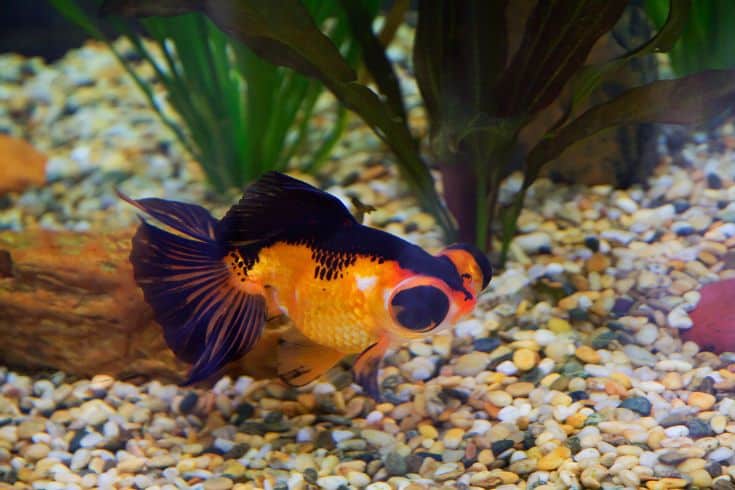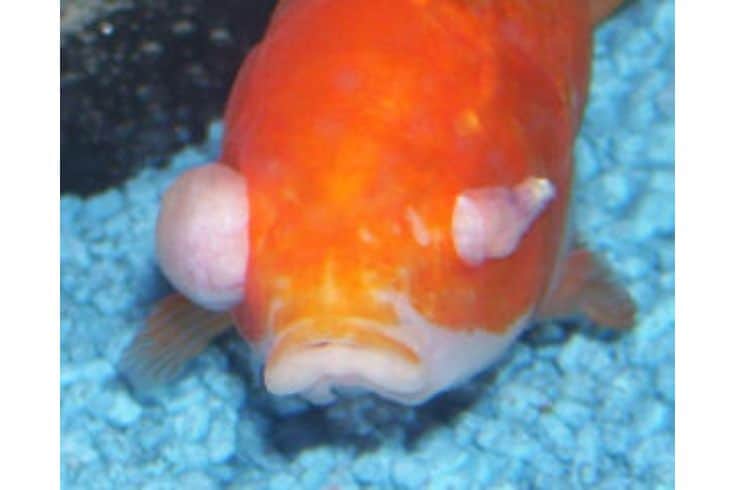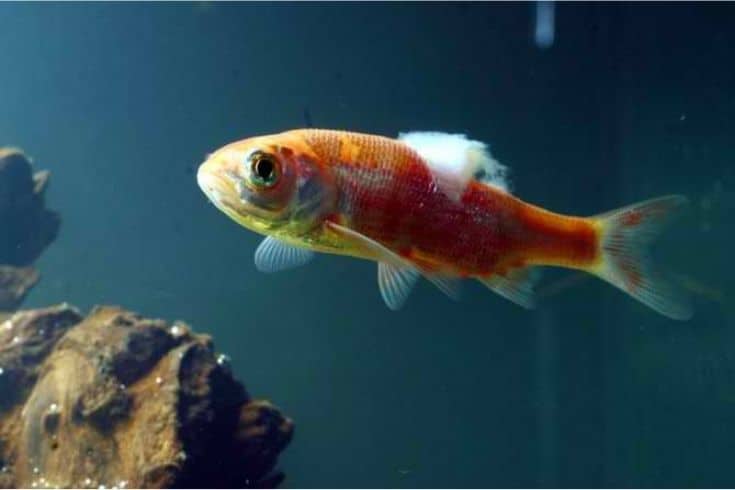Goldfish are some of the most popular fish to keep as pets. They are relatively low-maintenance and can be a fun addition to any home. However, like all animals, goldfish can sometimes fall ill. One common issue that goldfish face is problems with their eyes. In this article, we will discuss several different eye conditions in goldfish, their causes, and how they can be treated.
Eye Problems in Goldfish
A myriad of eye-related problems can affect goldfish. Some of the more common problems include:
Popeye
Often regarded as a common and easily treatable goldfish eye problem, popeye results from bacterial infections, physical damage, or a foreign object lodged in the goldfish’s eye socket. The most noticeable symptom of popeye disease is the bulging of the affected eye out of its socket. In more severe cases, the entire eye may appear to be protruding from the goldfish’s head.
While Popeye itself is not fatal, it can lead to secondary infections that can be deadly to your goldfish. If left untreated, Popeye can also cause permanent damage to the affected eye, including blindness.

Symptoms:
The most common symptom of Popeye is the bulging of one or both eyes out of their sockets. In more severe cases, the entire eye may appear to be protruding from the goldfish’s head. Other symptoms include:
- Cloudiness or opacity in the affected eye
- Redness or inflammation around the eye
- Discharge from the eye
- Swelling of the eyelids
It is important to note that none of these symptoms should be taken in isolation, as they can indicate other issues. Popeye is often accompanied by other infections, such as bacteria or fungi. If you notice any changes in your goldfish’s eyes, it is always best to seek professional advice from a qualified veterinarian aquarium specialist.
Causes:
Because popeye functions as a general catch-all term for any bulging eye condition in goldfish, there are a number of potential causes. The most common include:
- Bacterial infections
- Physical damage to the eye
- Foreign objects lodged in the eye socket
- Nutritional deficiencies
- Exposure to high levels of ammonia
In some cases, Popeye may be caused by an underlying health condition, such as an immune system disorder, a kidney infection, or a myriad of other dangerous infections. However, in most cases, popeye is triggered by suboptimal water parameters and irregular tank water changes.
Treatment:
The good news is that Popeye is a fairly easily treatable condition in goldfish. In most cases, the bulging eyes will return to normal within a few weeks with no lasting damage. However, Popeye can lead to secondary infections that can be deadly to your goldfish if left untreated.
To treat this condition, you should first improve the water quality of your goldfish tank. As with most goldfish eye injuries, effective treatment begins with creating a good, clean environment. Thereafter, experiment with simple salt bath treatments to reduce the swelling.
If the Popeye is caused by an infection or something more severe such as goldfish tuberculosis, you will need to acquire fish-specific medications from the vet. As always, prevention is better than cure. You can help to prevent Popeye in your goldfish by maintaining optimal water parameters. It is also important to provide your goldfish with a balanced diet to avoid nutritional deficiencies.
Corneal Injuries
Description:
Corneal injuries are one of the most common goldfish eye problems, and can occur when a piece of gravel hits the fish and bumps into something in the tank. The cornea is the clear outer layer of the eye, and injuries to this area can cause cloudiness, redness, and inflammation. Corneal injuries can lead to ulcers or even blindness in more severe cases.
Another way to think about corneal injuries is getting a cut on your finger. The cornea is a very thin and delicate layer, so even a small injury can cause serious problems. Couple this with the fact that goldfish are constantly submerged in water filled with microorganisms, and it’s no wonder that corneal injuries are so common.

Symptoms:
The most common symptom of a corneal injury is cloudiness or opacity in the affected eye. In more severe cases, you may also see:
- Redness or inflammation around the eye
- Swelling of the eyelids
- Discharge from the eye
- Ulcers on the cornea
Corneal injuries can be very painful for your goldfish, so it is important to seek professional advice from a qualified veterinarian as soon as possible. This is especially important if your goldfish displays additional symptoms beyond what we’ve already covered. You want to provide your pet with adequate treatment no matter what condition they may be afflicted by, and a vet is the best person to consult.
Causes:
Corneal injuries are usually caused by physical trauma to the eye, such as being hit by a piece of gravel or bumping into something in the tank. The physical contact damages the delicate cornea, causing inflammation and cloudiness.
In some cases, corneal injuries can also be caused by bacterial infections, parasitic infections, or exposure to harmful chemicals. An eye infection can cause ulcers to form on the cornea, which can be extremely painful for your goldfish.
Large-eyed goldfish are also more susceptible to these types of injuries compared to wild goldfish or even other species of fancy goldfish. Their protruding eyes are more susceptible to localized infections and external injuries.
Treatment:
Corneal injuries are treated in much the same way as any other wound. The first step is to clean the wound with a sterile saline solution. This will help to flush out any bacteria or debris that could cause an infection.
Your veterinarian may also prescribe oral antibiotics to treat a bacterial infection in some cases. Keeping the affected eye clean and free of debris during the healing process is important.
Because many factors can cause corneal injuries, treatment procedures will often be comprehensive to rule out every possible cause. You will also need to reduce fish stress by improving the layout of the tank and paying attention to their needs.
Fungal Infections
Description:
Fungal infections are one of the most common goldfish eye problems, and can occur when the fish is exposed to dirty water. Saprolegnia is the most common type of fungus that affects goldfish, and it typically appears as white or grayish growths on the fish’s skin.
Another common culprit is Achlya, which appears as red or pink growths on the skin. Fungal infections can occur on any part of the fish’s body, but are most common on the fins and tail. Under some unusual circumstances, fungal infections can also affect the eyes.

Symptoms:
The most common symptom of a fungal infection is the presence of white or grayish growths on the skin. These growths are typically fuzzy or cotton-like in appearance, and can range in size from a few millimeters to several centimeters. In some cases, the growths may also be red or pink in color.
Fungal infections can also cause the fish’s skin to become irritated and inflamed. The fish may also scratch at the affected area, causing further irritation. The fungus can spread to the eyes and cause cloudiness or inflammation in severe cases.
Causes:
Fungal infections are typically caused by exposure to improper water conditions and/or muddy waters. High levels of ammonia or nitrites can create an environment conducive to fungal growth. Poor water conditions and overcrowding are also major risk factors.
Treatment:
Fungal infections are best treated with a combination of antibiotics and antifungals. The most common antibiotic used to treat fish is Kanamycin, which is available in both injectable and oral forms. Antifungal medications such as Clotrimazole and Miconazole are commonly used to treat fungal infections.
It is important to treat both the sick fish and the tank with antibiotics and antifungals to prevent the infection from spreading. The fish should also be isolated from other fish during treatment. Filling a treatment tank with specialized treatments in appropriate doses should help your fish feel better. You should give your fish time to respond to the treatment and keep a lookout for additional signs of illnesses.
In addition, you should also make sure your fish has access to pristine water conditions throughout its treatment. To make sure it stays healthy after it recovers, be sure to conduct routine water changes and test your water frequently to maintain stable water parameters. You should also invest in a gravel vacuum to clean fish droppings trapped in the substrate.
Cataracts
Description:
Much like in humans, cataracts can form in goldfish as they age. Cataracts are a buildup of proteins in the lens of the eye and can cause the eye to become cloudy or opaque. In some cases, cataracts may also cause blindness.
Cataracts typically form gradually and may not be noticeable in the early stages. As cataracts continue to grow, they will eventually obscure the fish’s vision. This usually takes place over the course of several months or years, but in some cases, cataracts can form very quickly.

Symptoms:
The most common symptom of cataracts is cloudiness in the eye. The cloudiness may be white, gray, or yellow and will gradually worsen. In some cases, cataracts may also cause the fish’s eyes to appear milky or opaque.
The earliest sign of a cataract can be difficult to spot as it looks like a tiny spot in the middle of your fish’s eye. As cataracts grow, they will eventually obscure the fish’s vision. This can cause the fish to bump into objects, or have trouble finding food. In severe cases, cataracts may cause blindness.
Causes:
Cataracts typically form as a result of old age. As the years pass, the eye of goldfish becomes cloudy due to protein buildup. This obscures vision and may eventually lead to blindness. Unlike most other ailments on this list, cataracts have little to do with poor water parameters. Instead, they are more likely to be the result of physiological changes.
Treatment:
Cataracts cannot be reversed, but they can be treated with surgery. Surgery is typically only performed on otherwise healthy goldfish and is not recommended for blind goldfish or pets with other health problems.
The surgery involves making an incision in the eye and removing the cloudy lens. A new lens can then be inserted to improve the fish’s vision. After surgery, the fish will need to be monitored closely to ensure that the wound heals properly.
Because this procedure requires the expertise of a fish specialist, it is very rarely performed on household pets. Healthy fish housed in zoos and aquariums are more likely candidates for this treatment approach.
Missing Eyeball
Description:
This is perhaps the most obvious goldfish eye problem, which is sure to cause alarm in any owner. A missing eyeball can occur for a number of reasons, including injury, infection, or disease. When an injury has progressed to the point where an eyeball is completely missing, it is called enucleation.
Under some circumstances, the eyeball may simply pop out of the socket on its own. This is usually precipitated by an injury, but can also be caused by a tumor or other growth. In these cases, the eyeball can usually be popped back into place and heal normally.
However, if the eyeball has been completely removed, it cannot be replaced. The fish will have to learn to live without its eyeball, and will be at a disadvantage when competing for food. Many fish make do by relying on their sense of smell, but your fish will perpetually be at a disadvantage compared to other fish in the tank.
Symptoms:
The most obvious symptom of a missing eyeball is the absence of an eyeball. In some cases, the socket may also be empty, or there may be a mass of tissue in its place. In other cases, the eyelid may simply be covering the socket.
A fish with a missing eyeball will typically have trouble swimming and may bump into objects. The fish may also have trouble finding food and may lose weight as a result. If you have a blind goldfish in your tank, know that there are ways to feed it effectively and help it live a long, healthy life.
Causes:
A missing eyeball can be caused by injury, infection, or disease. Injury is the most common cause, and can occur if the fish bumps into something or is attacked by another fish. Infection and disease are less common causes, but can still result in losing an eye.
If a disease or infection causes your fish’s missing eyeball, it is important to treat the underlying condition and the missing eye.
Treatment:
If the eyeball has been lost due to injury, not much can be done. The fish will simply have to adapt to its new condition.
However, if the eyeball has been lost due to infection or disease, it is important to treat the underlying condition. This may involve using antibiotics or antifungals. In some cases, surgery may also be necessary to remove the infected tissue.
After the underlying condition has been treated, the fish will need time to adjust to its new appearance. Some fish may never fully recover from the loss of an eye, but many are able to live relatively normal lives.
The Takeaway
Goldfish eye problems can be caused by various factors, including injury, infection, and disease. In some cases, the problem may be present at birth. No matter what the cause, it is important to seek treatment as soon as possible to ensure the best possible outcome for your fish.
If you think your fish may be suffering from a goldfish eye problem, take it to the vet for a check-up. With prompt treatment, many goldfish can live happy and healthy lives despite their eye problems. In many cases, goldfish make a full recovery! So, don’t despair if your fish has an eye problem – there is hope!
We hope you have found this article helpful. If you have any questions or concerns, please feel free to reach out to us. We are always happy to help!
